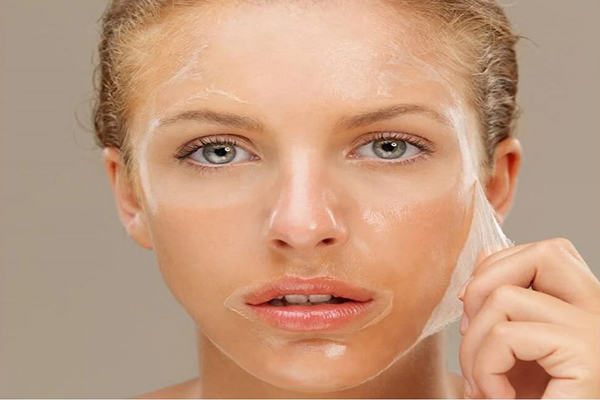- HOME
- ABOUT
- TREATMENTS
- BEFORE AND AFTER
- BLOG
- BOOK AN APPOINTMENT
- CONTACT
Chemical Peels: How Chemical Peels Can Improve Skin Tone and Complexion with the help of Dr Sheenam, a dermatologist based in Chandigarh
Chemical peels are a popular cosmetic treatment that have been used for decades to rejuvenate the skin. They involve applying a chemical solution to the skin, which causes the outer layers to peel off, revealing fresh, smooth, and more evenly toned skin underneath. For those looking to improve their skin tone and complexion, chemical peels offer a non-invasive yet highly effective solution. In this article, we will explore how chemical peels work, the types of peels available, and the benefits they provide for enhancing skin tone and complexion.
A chemical peel is a cosmetic treatment that exfoliates the top layers of skin using a specialized chemical solution. This controlled exfoliation removes damaged skin cells and stimulates the production of new, healthy skin cells. As a result, the skin appears more youthful, with fewer blemishes, wrinkles, and irregularities in tone and texture.

Chemical peels work by applying an acid-based solution to the skin, which induces controlled damage to the outer layers. Over the next few days to weeks, the damaged skin peels away, revealing new skin that is smoother, brighter, and more even in color. Depending on the depth of the peel, this treatment can address a range of skin concerns from mild discoloration to deep wrinkles.
There are three main types of chemical peels, categorized by their depth and intensity:
Superficial Peels by Dr Sheenam, a dermatologist: These are the mildest form of chemical peels and use gentle acids like glycolic acid or lactic acid to exfoliate the outermost layer of the skin. Superficial peels are ideal for individuals with minimal skin concerns, such as light sun damage or mild hyperpigmentation. They require little to no downtime, making them a popular choice for those with busy lifestyles.
Best for: Dull skin, mild pigmentation, uneven skin tone, and acne-prone skin.
Medium Peels: Medium-depth peels penetrate deeper into the skin, reaching the middle layers. Trichloroacetic acid (TCA) is commonly used in these peels, making them more effective for treating moderate skin concerns, such as sun spots, age spots, fine lines, and acne scars. Medium peels require more recovery time than superficial peels but deliver more noticeable results.
Best for: Sun damage, deeper pigmentation, fine lines, and mild acne scars.
Deep Peels: Deep chemical peels use stronger acids, such as phenol, to penetrate the skin’s deeper layers. These peels provide dramatic improvement for severe skin concerns, including deep wrinkles, pronounced pigmentation, and scarring. Due to their intensity, deep peels require significant downtime and should only be performed by a qualified professional.
Best fort: Severe wrinkles, deep scars, and extensive sun damage.
One of the primary benefits of chemical peels is the noticeable improvement in skin texture. By removing the outer layers of damaged skin, chemical peels reveal smoother, softer skin underneath. This results in a more youthful appearance, as rough patches, dry skin, and surface-level imperfections are minimized.
Uneven skin tone, often caused by hyperpigmentation, acne scars, or sun damage, can be effectively treated with chemical peels. The exfoliation process encourages new, evenly pigmented skin cells to emerge, which reduces the appearance of dark spots, sun spots, and melasma. Regular chemical peels can help achieve a more uniform complexion by breaking down clusters of pigmentation over time.
Dull skin is often the result of dead skin cells accumulating on the surface. Chemical peels remove these dead cells, allowing new, healthy skin to come to the surface. As a result, the skin looks more radiant and fresh. Superficial peels, in particular, are effective at giving the skin a bright, glowing appearance with minimal recovery time.
By stimulating collagen production, medium and deep chemical peels help to reduce the appearance of fine lines and wrinkles. Collagen is a key protein that keeps the skin firm and youthful. With regular treatments, chemical peels can improve skin elasticity, making fine lines and wrinkles less noticeable.
Chemical peels, especially those containing salicylic acid, are effective for treating acne-prone skin. They work by clearing clogged pores, reducing oil production, and exfoliating dead skin cells that contribute to acne breakouts. Additionally, chemical peels can help fade acne scars by encouraging cell turnover and skin regeneration.
Enlarged pores are a common concern, particularly for individuals with oily or combination skin. Chemical peels help to minimize the appearance of pores by exfoliating the skin and removing the debris that clogs them. With consistent treatment, the skin’s texture becomes more refined, and pores appear smaller.
After a chemical peel, the skin is more receptive to skincare products since the outer layer of dead skin cells has been removed. This allows active ingredients in serums, moisturizers, and other treatments to penetrate more deeply, making them more effective.
While chemical peels can yield impressive results, proper post-peel care is crucial for ensuring the best outcome. After a peel, the skin is more sensitive and vulnerable to sun damage, so wearing broad-spectrum sunscreen with an SPF of 30 or higher is essential. It’s also important to keep the skin moisturized and avoid picking at any peeling skin, as this can lead to scarring.
Additionally, depending on the depth of the peel, downtime can vary from a few days to a few weeks. Superficial peels usually require little to no recovery time, while medium and deep peels may involve redness, peeling, and swelling for a longer period.
Chemical peels are a highly effective way to improve skin tone and complexion. Whether you’re dealing with pigmentation issues, fine lines, acne, or dull skin, chemical peels offer a customizable solution to address your concerns. By removing damaged skin cells and stimulating collagen production, chemical peels help reveal smoother, brighter, and more even-toned skin. For the best results, it’s important to consult with a dermatologist or licensed aesthetician to determine the right type of peel for your skin type and concerns.
Please fill up the Form below so that we can get
in touch with you at the earliest.

Call us:
+91-90416-25252
Visit Clinic:
Dr. Sheenam's Skin, Hair & Laser Clinic
# 1, Sector 21 - D
Chandigarh
Email:
drsheenamskinclinic@gmail.com